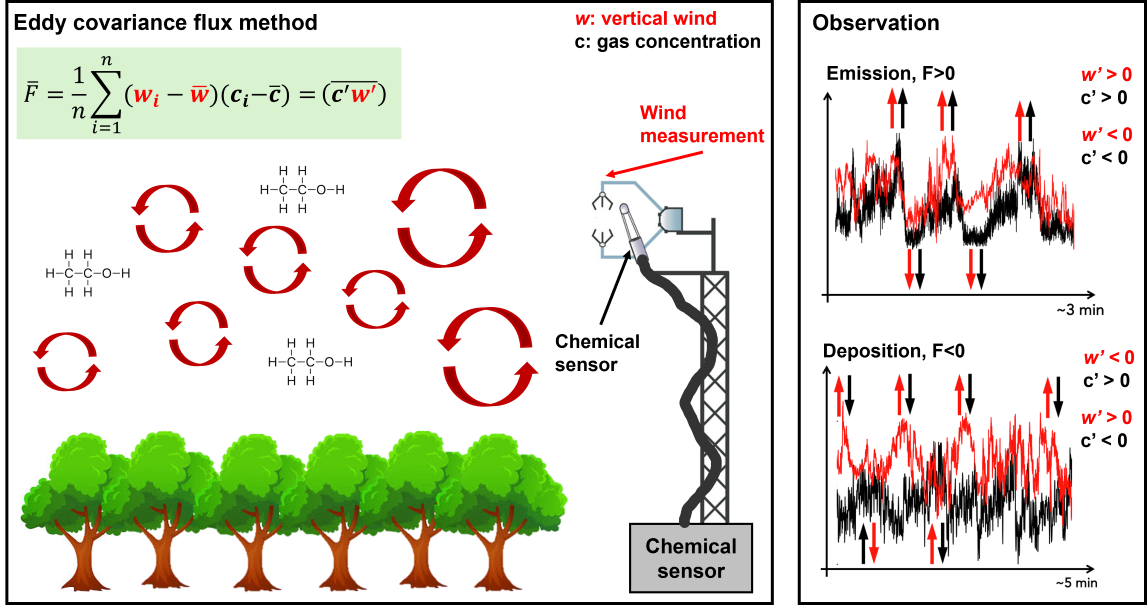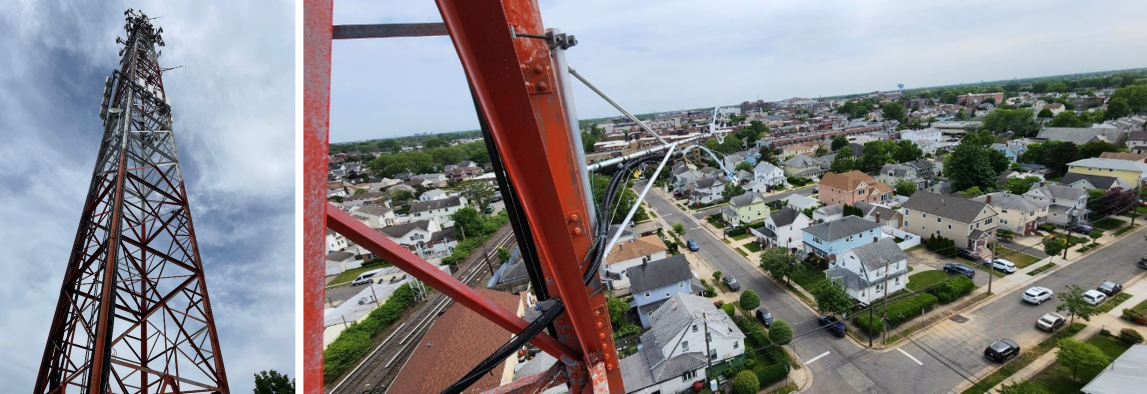Biosphere-atmosphere interactions and atmospheric chemistry

We use the eddy covariance method to directly observe the vertical turbulent flux, or emissions and deposition, of reactive trace gases over an ecosystem.
The surface-atmosphere exchange of reactive trace gases plays a major role in modifying the chemical and physical properties of the atmosphere. In particular, the terrestrial biosphere is a major source of biogenic volatile organic compounds (VOCs) to the atmosphere (∼1000 Tg C yr−1) that is nearly an order of magnitude larger than anthropogenic sources. These VOCs govern atmospheric concentrations of the hydroxy radical (OH) and ozone (O3) and control the formation and growth of secondary organic aerosol (SOA). Biosphere-atmosphere exchange is also responsible for ~20% of the global sink of the pollutant ozone (O3) via irreversible uptake through plant stomata plus nonstomatal loss to other surfaces. Developing an improved understanding of biosphere-atmosphere exchange is thus an important science priority.

Processes like enhancements of VOC emissions during leaf senescence are currently missing from simulations of reactive carbon in the atmosphere and can be a missing source of reactivity (Vermeuel, et al. 2023).
Representative publications:
- Vermeuel, M.P. et al., J. Geophys. Res. Atmos., https://doi.org/10.1029/2024JD042092, 2024
- Vermeuel, M.P. et al., Atmos. Chem. Phys., https://doi.org/10.5194/acp-23-4123-2023, 2023
- Vermeuel, M.P. et al., J. Geophys. Res. Atmos., https://doi.org/10.1029/2023JD038753, 2023
- Vermeuel, M.P. et al., Geophys. Res. Lett, https://doi.org/10.1029/2020GL090996, 2021
Urban air quality and the identification of pollutant sources and sinks

The pollutant ozone (O3) is the product of catalytic cycling of hydrogen oxides (HOx = OH + HO2) and nitrogen oxides (NOx = NO + NO2), with its production nonlinearly dependent on volatile organic compounds (VOCs) and NOx (right).
Tropospheric ozone (O3) is a pollutant that is harmful to human health and plant productivity and can control atmospheric composition through the oxidative removal of reactive trace gases. O3 also impacts climate by acting as a greenhouse gas and participating in particulate production, both of which contribute to the earth’s radiation budget. VOCs emitted into the urban atmosphere are one of the needed ingredients for O3 and aerosol formation and there is a wide array of VOC sources in urban environments. These include fossil-fuel combustion, consumer-driven volatile chemical products, cooking, the decomposition of interior and exterior building materials, and vegetative emissions. A current lack of chemically-detailed urban flux measurements thus imply uncertainties in air quality predictions and estimates of urban aerosol formation which in turn may compromise air quality policy design, community impact assessments of pollutants. To address this our group makes observations over urban regions to directly identify known and unknown reactive trace gases and their contributions to chemistry.

Eddy covariance flux studies look a lot like the images above. Here, we measured of VOCs and O3, along with many other trace gases, on Long Island, NY as part of the FROG-NY and AEROMMA field studies.
Representative publications:
- Vermeuel, M. P. et al., J. Geophys. Res. Atmos., https://doi.org/10.1029/2019JD030842, 2019
- Vermeuel, M.P., et al., Final Memo for Lake Michigan Air Directors Consortium (LADCO), report link (PDF), 2020
Unraveling the fate of trace gases with multidimensional atmospheric chemistry models

We use a variety of models to answer open questions regarding atmospheric chemistry. We don't have a favorite in this group.
Predictions of reactive gases involve chemical transport models (CTMs) that then inform decision-making aimed at controlling surface pollution and its negative health and ecological impacts. We use a combination of models across different scales such as the 0D F0AM box model, the 1D MLC-CHEM model, and the GEOS-Chem 3D CTM to improve our understanding of the fate of reactive gases in the atmosphere.

Global surface O3 simulated with the GEOS-Chem 3D chemical transport model.
Representative publications:
- Vermeuel, M.P. et al., J. Geophys. Res. Atmos., https://doi.org/10.1029/2024JD042092, 2024
- Vermeuel, M.P. et al., J. Geophys. Res. Atmos., https://doi.org/10.1029/2023JD038753, 2023
- Vermeuel, M.P. et al., Environ. Sci. Technol., https://doi.org/10.1021/acs.est.0c04323, 2020
- Vermeuel, M. P. et al., J. Geophys. Res. Atmos., https://doi.org/10.1029/2019JD030842, 2019
Advanced mass spectrometry methods for the sensitive detection of atmospheric chemicals

Simultaneous mass spectra sampling over a pine forest covering thousands of gaseous species (Vermeuel et. al, 2023).
With up to 105 different organic species thought to exist in the atmosphere there are open questions regarding the number of VOCs contributing to atmospheric chemistry as well as the contributions of other inorganic species. To address this, we use a range of highly selective and sensitive chemical ionization mass spectrometry (CIMS) methods to identify these different chemicals in the atmopshere. One technique, proton-transfer reaction mass spectrometry (PTRMS), measures a wide suite of reduced VOCs and can capture a large portion of gas-phase VOC carbon over forests and cities. Field deployable negative-ion CIMS methods (e.g., using iodide, I−) can detect molecules not present in the PTRMS spectrum such as more oxidized VOCs, organic nitrates, organosulfur compounds, and other inorganic species.
Representative publications:
- Vermeuel, M.P. et al., J. Geophys. Res. Atmos., https://doi.org/10.1029/2023JD038753, 2023